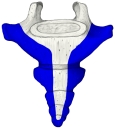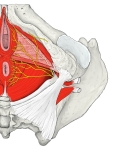肛門挙筋 ( こうもんきょきん、 英 : levator ani )
・ 概 要 |
・ 作 用 |
・ イラスト掲載サイト |
|
・ イラスト |
・ 神経 / 脈管 |
||
・ 起始 / 停止 |
・ Wikipedia |
![]()


・ 骨盤底筋群 の1つとなる。
・ 薄く幅のある漏斗状の筋板の先端は肛門 (anus) を囲んでいる。
・ 「女では、一部は膣の縦走筋と結合する。」( 日本人体解剖学 )
![]()

以下は「船戸和也のHP」の解説文となる。
「肛門挙筋の丈夫な前部(恥骨尾骨筋)は分界線直下の恥骨の内面から起こり、薄い後部(腸骨尾骨筋)は腸骨から起こる。その起始腱は内閉鎖筋筋膜に接して移行し、閉鎖筋膜から発する腱束を受ける。これらの線維の起始部では腱性の係留物(肛門挙筋腱弓)により強化されている。左右両側で恥骨尾骨筋の内側線維束は挙筋脚を形成している。それらの線維束は背方と尾方、また直腸の前では外側を通り、それぞれ会陰の中心腱へ放散する薄い前直腸線維束や前立腺挙筋として前立腺筋膜(あるいは恥骨腟筋として腟壁)へと分かれる。それより鼻側にある肛門挙筋の線維束は恥骨直腸筋として直腸の背側を取り囲み、反対側の線維と共にループを形成する。恥骨尾骨筋の外側束は尾骨と仙骨の背側に広がる。腸骨尾骨筋の筋線維は尾骨と仙骨に付き、また肛門と尾骨の間では強靱な線維束である肛門尾骨靱帯に付いている。」
また、「Rauber-Kopsch 解剖学」では以下のように解説している。
「 両側の肛門挙筋は(尾骨筋とともに)1つのロート状にかたむいた筋板をなしていて,この筋板は骨盤出口を塞ぐことにあずかっており,それゆえに骨盤隔膜Diaphragma pelvisともよばれる.左右の肛門挙筋の前縁のあいだには正中に隙間があって“Levatortor”(挙筋門の意)といい,そのなかに前立腺の尖端がはいっている.肛門挙筋は各側とも恥骨結合の後面から坐骨棘にいたる1線から起こっている.特にその筋線維は恥骨枝の寛骨臼部の内面と閉鎖筋膜腱弓Arcus tendineus fasciae obturatoriaeから起こっている.そして膀胱,前立腺(あるいは腟),直腸の側面に沿って後方にすすみ,前立腺とは固く着いている,また直腸の縦走筋層は肛門挙筋の束のあいだに終わっているので,この筋は直腸の壁とも密着している. 」
![]()
 |
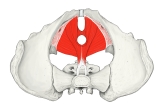 |
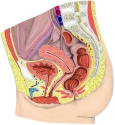 |
||
 |
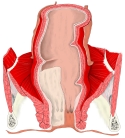 |
 |
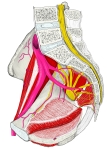 |
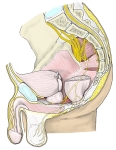 |
![]()
【 起 始 】 : 恥骨結合と坐骨棘の間の肛門挙筋腱弓および恥骨上枝
![]()
「 肛門挙筋は骨盤内臓を支持し、直腸と膣が閉じた状態を維持するのを助ける。 」 ( グレイ解剖学 )
![]()
・ 神 経 : S4前枝からの直接の枝および陰部神経(S2~S4)の枝によって支配される。 ( グレイ解剖学 )
・ 脈 管 :
The levator ani is a broad, thin muscle, situated on the side of the pelvis. It is formed from three muscle components: the puborectalis, the pubococcygeus muscle (of which the puborectalis is part of) and the iliococcygeal muscle.
It is attached to the inner surface of the side of the lesser pelvis, and unites with its fellow of the opposite side to form the greater part of the pelvic floor.
It supports the viscera in the pelvic cavity, and surrounds the various structures that pass through it.
In combination with the coccygeus muscle, it forms the pelvic floor also called the pelvic diaphragm.
【 Structure 】
The levator ani is divided into three parts:
- Iliococcygeus muscle ( 腸骨尾骨筋 )
- Pubococcygeus muscle ( 恥骨尾骨筋 )
- Puborectalis muscle ( 恥骨直腸筋 )
The pubococcygus muscle is then divided into three parts on its own.
- The true pubococcygeus
- puborectalis
- pubovaginalis (female) or puboprostaticus (male)
【 語 句 】
・ pelvis : 骨盤 ・ lesser pelvis : 小骨盤 ・ pelvic floor : 骨盤底 ・ viscera : 内臓 ・pelvic cavity:骨盤腔 ・coccygeus muscle:尾骨筋 ・pelvic diaphragm:骨盤隔膜 ・pubovaginalis:恥骨膣筋 ・puboprostaticus:恥骨前立腺筋
【 Origin and insertion 】
The levator ani arises, in front, from the posterior surface of the superior pubic ramus lateral to the symphysis; behind, from the inner surface of the spine of the ischium; and between these two points, from the obturator fascia.
Posteriorly, this fascial origin corresponds, more or less closely, with the tendinous arch of the pelvic fascia, but in front, the muscle arises from the fascia at a varying distance above the arch, in some cases reaching nearly as high as the canal for the obturator vessels and nerve.
The fibers pass downward and backward to the middle line of the floor of the pelvis; the most posterior are inserted into the side of the last two segments of the coccyx; those placed more anteriorly unite with the muscle of the opposite side, in a median fibrous raphé (anococcygeal raphé), which extends between the coccyx and the margin of the anus.
The middle fibers are inserted into the side of the rectum, blending with the fibers of the Sphincter muscles; lastly, the anterior fibers descend upon the side of the prostate to unite beneath it with the muscle of the opposite side, joining with the fibers of the external anal sphincter and transversus perinei, at the central tendinous point of the perineum.
The anterior portion is occasionally separated from the rest of the muscle by connective tissue.
From this circumstance, as well as from its peculiar relation with the prostate, which it supports as in a sling, it has been described as a distinct muscle, under the name of levator prostatæ.
In the female the anterior fibers of the levator ani descend upon the side of the vagina.
【 Innervation 】
The levator ani muscles are mostly innervated by the pudendal nerve, perineal nerve and inferior rectal nerve acting together.
【 Variation 】
In addition, sacral spinal nerves (S3, S4) innervate the muscles directly as well (in ~70%of people). Sometimes (in ~40% of people) the inferior rectal nerve innervates the levator ani muscles independently of the pudendal nerve.
【 Function 】
The levator ani muscles, are responsible for "wagging" the tail in tailed quadrupeds.These muscles are not as strong in the human, as tail-wagging is more demanding than the support function that the muscles serve in humans.
【 語 句 】
・ superior pubic ramus : 恥骨上枝 ・ symphysis : 線維軟骨結合 ・ spine of the ischium : 坐骨棘 ・ obturator fascia : 閉鎖筋膜 ・ pelvic fascia : 骨盤筋膜 ・ varying : 変わる ・ anus : 肛門 ・ rectum : 直腸 ・ prostate : 前立腺 ・ external anal sphincter : 外肛門括約筋 ・ transversus perinei : 会陰横筋? ・ perineum : 会陰 ・ connective tissue : 結合組織 ・ peculiar : 特有の ・ sling : 吊り索 ・ distinct : 別個の ・ levator prostatae : 前立腺挙筋 ・ vagina : 膣 ・ pudendal nerve : 陰部神経 ・ perineal nerve : 会陰神経 ・ inferior rectal nerve :下直腸神経 ・ sacral spinal nerves : 仙骨神経? ・ wagging : 振り動かす ・ quadrupeds : 四足獣
![]()
・ イラストを掲載しているサイト-Ⅳ (断面)




